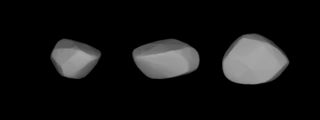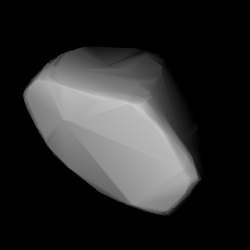Related Research Articles
2069 Hubble, provisional designation 1955 FT, is a carbonaceous asteroid from the outer region of the asteroid belt, approximately 40 kilometers in diameter. It was discovered on 29 March 1955, by the Indiana Asteroid Program at Goethe Link Observatory, United States, and named after American astronomer Edwin Hubble.

1743 Schmidt, provisional designation 4109 P-L, is a dark background asteroid from the inner regions of the asteroid belt, approximately 19 kilometers in diameter. It was discovered during the Palomar–Leiden survey on 24 September 1960, by astronomers Ingrid and Cornelis van Houten at Leiden, on photographic plates taken by Tom Gehrels at Palomar Observatory in California. The C-type asteroid has a rotation period of 17.5 hours. It was named for the optician Bernhard Schmidt.
606 Brangäne, provisional designation 1906 VB, is an asteroid from the central regions of the asteroid belt, approximately 36 kilometers in diameter. It was discovered on 18 September 1906, by astronomer August Kopff at the Heidelberg Observatory in southwest Germany. The unusual K-type asteroid is the namesake of the small Brangäne family and has a rotation period of 12.3 hours. It was named after Brangaine, a character from the opera Tristan und Isolde by Richard Wagner.
Pawlowia, provisional designation 1923 OX, is a background asteroid from the central regions of the asteroid belt, approximately 20 kilometers in diameter. It was discovered on 5 October 1923, by Soviet astronomer Vladimir Albitsky at the Simeiz Observatory on the Crimean peninsula. The asteroid was named after Russian physiologist and Nobelist Ivan Pavlov.
1024 Hale, provisional designation A923 YO13, is a carbonaceous background asteroid from the outer regions of the asteroid belt, approximately 45 kilometers (28 miles) in diameter. The asteroid was discovered on 2 December 1923, by Belgian–American astronomer George Van Biesbroeck at the Yerkes Observatory in Wisconsin, United States. It was named for American astronomer George Ellery Hale. The dark C-type asteroid may have a rotation period of 16 hours.
1028 Lydina, provisional designation 1923 PG, is a carbonaceous background asteroid and member of the Cybele group from the outermost regions of the asteroid belt, approximately 82 kilometers in diameter. It was discovered at the Simeiz Observatory on the Crimean peninsula on 6 November 1923, by Soviet astronomer Vladimir Albitsky, who named it after his wife, Lydia Il'inichna Albitskaya. The dark C-type asteroid has a rotation period of 11.68 hours.

1032 Pafuri, provisional designation 1924 SA, is a dark background asteroid from the outer regions of the asteroid belt, approximately 65 kilometers in diameter. It was discovered on 30 May 1924, by English astronomer Harry Edwin Wood at the Union Observatory in Johannesburg, South Africa. The asteroid was named for the river in the Pafuri Triangle in South Africa, created by the confluence of the Limpopo and Levubu rivers. The body's spectral type and rotation period are still poorly determined.
1815 Beethoven, provisional designation 1932 CE1, is a carbonaceous background asteroid from the outer regions of the asteroid belt, approximately 30 kilometers (19 miles) in diameter. It was discovered on 27 January 1932, by German astronomer Karl Reinmuth at the Heidelberg Observatory. The uncommon F-type asteroid seems to have a long rotation period of 54 hours (tentative). It was named after Ludwig van Beethoven.
1240 Centenaria, provisional designation 1932 CD, is a background asteroid from the outer regions of the asteroid belt, approximately 60 kilometers in diameter. It was discovered on 5 February 1932, by astronomer Richard Schorr at the Bergedorf Observatory in Hamburg, Germany. The assumed C-type asteroid has a rotation period of 11.3 hours. It was named for the 100th anniversary of the discovering observatory.

1555 Dejan, provisional designation 1941 SA, is an asteroid from the background population of the central regions of the asteroid belt, approximately 22 kilometers in diameter. It was discovered on 15 September 1941, by Belgian astronomer Fernand Rigaux at the Royal Observatory of Belgium in Uccle. The asteroid was named after Dejan Đurković, son of Serbian astronomer Petar Đurković.

1241 Dysona, provisional designation 1932 EB1, is a dark background asteroid from the outer regions of the asteroid belt, approximately 77 kilometers in diameter. It was discovered on 4 March 1932, by English astronomer Harry Edwin Wood at the Union Observatory in Johannesburg, South Africa. The asteroid was named after English astronomer Frank Watson Dyson.
1372 Haremari, provisional designation 1935 QK, is a rare-type Watsonian asteroid and a suspected trojan of Ceres from the central regions of the asteroid belt, approximately 26 kilometers in diameter. It was discovered on 31 August 1935, by astronomer Karl Reinmuth at the Heidelberg-Königstuhl State Observatory in southwest Germany. The asteroid was named for all female staff members of the Astronomical Calculation Institute.
2324 Janice, provisional designation 1978 VS4, is a dark background asteroid from the outer regions of the asteroid belt, approximately 25 kilometers (16 miles) in diameter. It was discovered on 7 November 1978, by American astronomers Eleanor Helin and Schelte Bus at the Palomar Observatory in California. The asteroid was named for Janice Cline at Caltech. The presumably C-type asteroid has a rotation period of 23.2 hours.
3754 Kathleen, provisional designation 1931 FM, is a large background asteroid from the outer regions of the asteroid belt, approximately 55 kilometers in diameter. It was discovered at the Lowell Observatory near Flagstaff, Arizona, on 16 March 1931, by American astronomer Clyde Tombaugh, who named it after his granddaughter Kathleen Clifford. The assumed C-type asteroid has a rotation period of 11.18 hours. It is the second-highest numbered main-belt asteroid larger than 50 kilometers.
2173 Maresjev, provisional designation 1974 QG1, is a dark background asteroid from the outer regions of the asteroid belt, approximately 28 kilometers (17 miles) in diameter. It was discovered on 22 August 1974, by Soviet–Ukrainian astronomer Lyudmila Zhuravleva at the Crimean Astrophysical Observatory in Nauchnij, on the Crimean peninsula. It was named for Soviet war veteran Alexey Maresyev. The assumed C-type asteroid has a tentative rotation period of 11.6 hours.
1467 Mashona, provisional designation 1938 OE, is a rare-type carbonaceous asteroid from the outer regions of the asteroid belt, approximately 100 kilometers in diameter, making it one of the top 200 largest asteroids currently known to exist. It was discovered on 30 July 1938, by South African astronomer Cyril Jackson at the Johannesburg Observatory in South Africa. It was later named after the native Shona people of Zimbabwe.
3066 McFadden, provisional designation 1984 EO, is a stony background asteroid from the central regions of the asteroid belt, approximately 15 kilometers in diameter. It was discovered on 1 March 1984, by American astronomer Edward Bowell at the Anderson Mesa Station near Tucson, Arizona. It was named for American planetary scientist Lucy-Ann McFadden. The assumed S-type asteroid has a rotation period of 13.8 hours.
2043 Ortutay, provisional designation 1936 TH, is a dark asteroid from the outer regions of the asteroid belt, approximately 45 kilometers in diameter. The asteroid was discovered by Hungarian astronomer György Kulin at the Konkoly Observatory, Budapest, on 12 November 1936. It was named after Hungarian ethnographer Gyula Ortutay.

1197 Rhodesia, provisional designation 1931 LD, is a dark background asteroid from the outer regions of the asteroid belt, approximately 48 kilometers in diameter. It was discovered on 9 June 1931, by South African astronomer Cyril Jackson at the Union Observatory in Johannesburg. The likely C-type asteroid has a rotation period of 16.1 hours. It was named for Rhodesia, a former British colony and unrecognised state, which is now Zimbabwe.

2120 Tyumenia is a dark background asteroid, approximately 45 kilometers in diameter, located in the outer regions of the asteroid belt. It was discovered on 9 September 1967, by Soviet astronomer Tamara Smirnova at the Crimean Astrophysical Observatory in Nauchnyj, on the Crimean peninsula. The asteroid was named for the now Russian district of Tyumen Oblast in Western Siberia.
References
- 1 2 3 4 5 6 7 "1373 Cincinnati (1935 QN)". Minor Planet Center. Retrieved 13 December 2018.
- 1 2 3 4 "JPL Small-Body Database Browser: 1373 Cincinnati (1935 QN)" (2018-04-23 last obs.). Jet Propulsion Laboratory . Retrieved 13 December 2018.
- 1 2 3 4 5 "LCDB Data for (1373) Cincinnati". Asteroid Lightcurve Database (LCDB). Retrieved 13 December 2018.
- 1 2 3 Carruba, V.; Nesvorný, D.; Aljbaae, S.; Huaman, M. E. (July 2015). "Dynamical evolution of the Cybele asteroids". Monthly Notices of the Royal Astronomical Society. 451 (1): 244–256. arXiv: 1505.03745 . Bibcode:2015MNRAS.451..244C. doi:10.1093/mnras/stv997.
- 1 2 Licandro, J.; Alvarez-Candal, A.; de León, J.; Pinilla-Alonso, N.; Lazzaro, D.; Campins, H. (April 2008). "Spectral properties of asteroids in cometary orbits" (PDF). Astronomy and Astrophysics. 481 (3): 861–877. Bibcode:2008A&A...481..861L. doi: 10.1051/0004-6361:20078340 . Retrieved 13 December 2018.
- 1 2 3 4 Mainzer, A. K.; Bauer, J. M.; Cutri, R. M.; Grav, T.; Kramer, E. A.; Masiero, J. R.; et al. (June 2016). "NEOWISE Diameters and Albedos V1.0". NASA Planetary Data System: EAR-A-COMPIL-5-NEOWISEDIAM-V1.0. Bibcode:2016PDSS..247.....M . Retrieved 13 December 2018.
- 1 2 3 Masiero, Joseph R.; Grav, T.; Mainzer, A. K.; Nugent, C. R.; Bauer, J. M.; Stevenson, R.; et al. (August 2014). "Main-belt Asteroids with WISE/NEOWISE: Near-infrared Albedos". The Astrophysical Journal. 791 (2): 11. arXiv: 1406.6645 . Bibcode:2014ApJ...791..121M. doi:10.1088/0004-637X/791/2/121. S2CID 119293330.
- 1 2 3 4 5 6 Mainzer, A.; Grav, T.; Masiero, J.; Hand, E.; Bauer, J.; Tholen, D.; et al. (November 2011). "NEOWISE Studies of Spectrophotometrically Classified Asteroids: Preliminary Results". The Astrophysical Journal. 741 (2): 25. arXiv: 1109.6407 . Bibcode:2011ApJ...741...90M. doi:10.1088/0004-637X/741/2/90. S2CID 35447010. (catalog)
- 1 2 3 4 Usui, Fumihiko; Kuroda, Daisuke; Müller, Thomas G.; Hasegawa, Sunao; Ishiguro, Masateru; Ootsubo, Takafumi; et al. (October 2011). "Asteroid Catalog Using Akari: AKARI/IRC Mid-Infrared Asteroid Survey". Publications of the Astronomical Society of Japan. 63 (5): 1117–1138. Bibcode:2011PASJ...63.1117U. doi: 10.1093/pasj/63.5.1117 . (online, AcuA catalog p. 153)
- 1 2 3 4 Behrend, Raoul. "Asteroids and comets rotation curves – (1373) Cincinnati". Geneva Observatory. Retrieved 13 December 2018.
- 1 2 "Asteroid 1373 Cincinnati – Asteroid Taxonomy V6.0". Small Bodies Data Ferret. Retrieved 29 October 2019.
- ↑ De Prá, M. N.; et al. (September 2018), "PRIMASS visits Hilda and Cybele groups", Icarus, 311: 35–51, arXiv: 1711.02071 , Bibcode:2018Icar..311...35D, doi:10.1016/j.icarus.2017.11.012, S2CID 119383924.
- ↑ "Asteroid (1373) Cincinnati – Proper elements". AstDyS-2, Asteroids – Dynamic Site. Retrieved 25 May 2018.
- ↑ Schmadel, Lutz D. (2009). "Appendix – Publication Dates of the MPCs". Dictionary of Minor Planet Names – Addendum to Fifth Edition (2006–2008). Springer Berlin Heidelberg. p. 221. Bibcode:2009dmpn.book.....S. doi:10.1007/978-3-642-01965-4. ISBN 978-3-642-01964-7.
- ↑ Warner, Brian D. (March 2005). "Lightcurve analysis for asteroids 242, 893, 921, 1373, 1853, 2120, 2448 3022, 6490, 6517, 7187, 7757, and 18108". The Minor Planet Bulletin. 32 (1): 4–7. Bibcode:2005MPBu...32....4W. ISSN 1052-8091.
- ↑ Warner, Brian D. (January 2011). "Lightcurve Analysis at the Palmer Divide Observatory: 2010 June–September". The Minor Planet Bulletin. 38 (1): 25–31. Bibcode:2011MPBu...38...25W. ISSN 1052-8091.